1993 BUICK RIVIERA stop start
[x] Cancel search: stop startPage 89 of 324
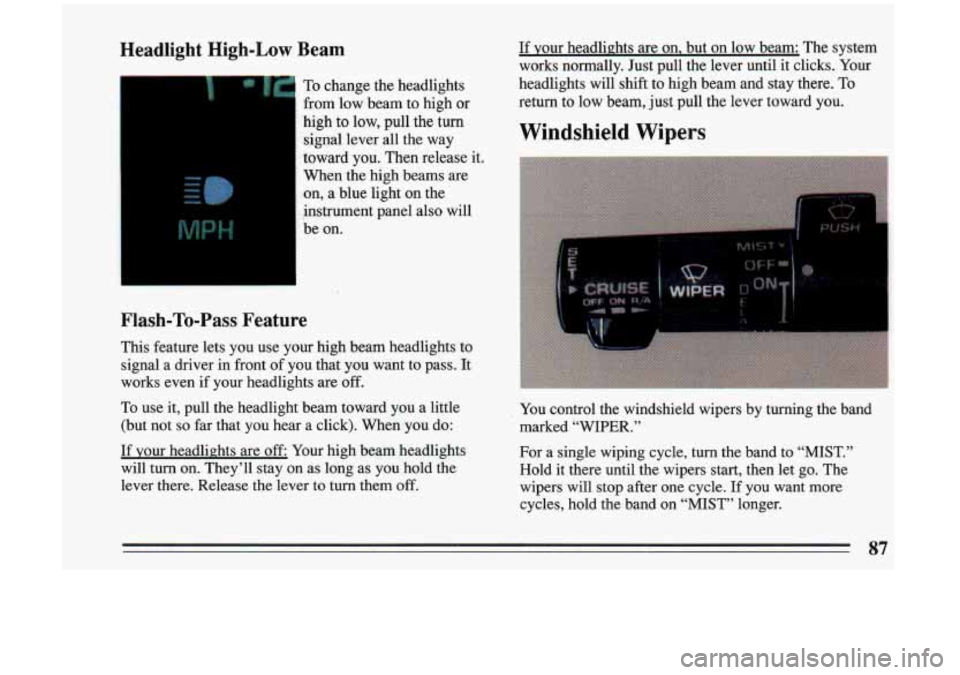
Headlight High-Low Beam
To change the headlights
from low beam to high or
high to low, pull the turn signal lever all the way
toward
you. Then release it.
When the high beams are
on, a blue light on the
instrument panel also will
be on.
If your headlights are on, but on low beam: The system
works normally. Just pull the lever until it clicks. Your
headlights will shift to high beam and stay there. To
return to low beam, just pull the lever toward you.
Windshield Wipers
Flash-To-Pass Feature
This feature lets you use your high beam headlights to
signal a driver in front of you that
you want to pass. It
works even if your headlights are
off.
To use it, pull the headlight beam toward you a little
(but not
so far that you hear a click). When you do:
If your headlights are off Your high beam headlights
will
turn on. They’ll stay on as long as you hold the
lever there. Release the lever to turn them
off.
.
. . . ~
You control the windshield wipers by turning the band
marked “WIPER.”
For a single wiping cycle, turn the band to
“MIST.”
Hold it there until the wipers start, then let go. The
wipers will stop after one cycle. If
you want more
cycles, hold the band on
“MIST” longer.
87
Page 113 of 324
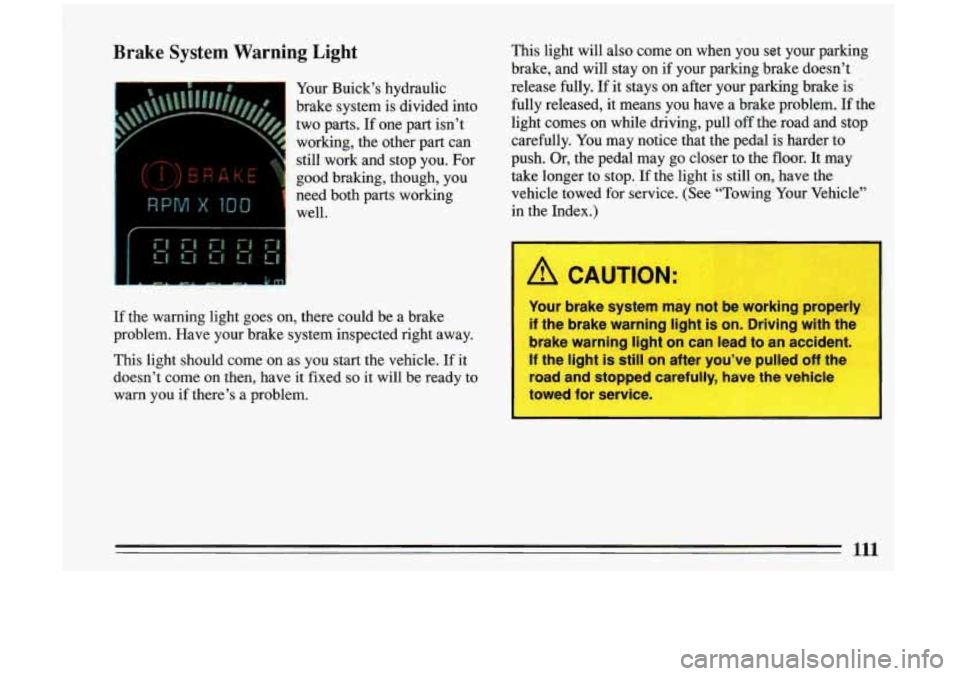
Brake System Warning Light
1 Your Buick’s hydraulic
I two parts. If one part isn’t
~ working, the other part can
~ still work and stop you. For ’ good braking, though, you
brake system is divided
into
1 well.
need both parts working
If the
warning light goes on, there could be a brake
problem. Have your brake system inspected right away.
This light should come on as you start the vehicle. If it
doesn’t come on then, have it fixed
so it will be ready to
warn you if there’s a problem. This light will
also come
on when you set your parking
brake, and will stay on if your parking brake doesn’t
release fully. If it stays on after your parking brake
is
fully released, it means you have a brake problem. If the
light comes on while driving, pull
off the road and stop
carefully. You may notice that the pedal is harder to
push. Or, the pedal may
go closer to the floor. It may
take longer to stop. If the light is still on, have the
vehicle towed for service. (See “Towing Your Vehicle”
in the Index.)
I A CAUTION:
Your brake system may not be working properly
if the brake warning light is on. Driving with the
brake warning light on can lead
to an accident.
If the light is still on after you’ve pulled off the
road and stopped carefully, have the vehicle
towed for service.
I
111
i
Page 114 of 324
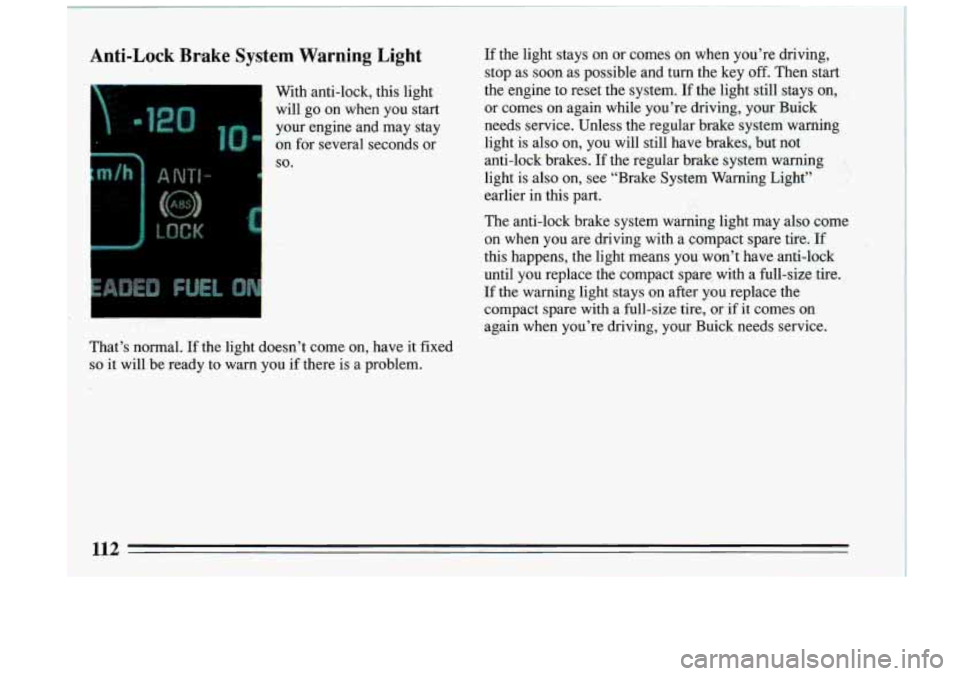
Anti-Lock Brake System Warning Light
1
I’
i
If the light stays on or comes on when you’re driving,
stop as soon as possible and turn the key off. Then start
With anti-lock, this light the engine to reset the system.
If the light still stays on,
will go on when you start or comes on again while you’re driving, your Buick
your engine and may stay needs service. Unless the regular brake system’ warning
on for several seconds or light is also on, you will still have brakes, but not
so. anti-lock brakes.
If the regular brake system warning
light
is also on, see “Brake System Warning Light”
earlier in this part.
The anti-lock brake system warning light may also come on when you are driving with
a compact spare tire. If
this happens, the light means you won’t have anti-lock
until you replace the compact spare, with a full-size tire.
If the warning light stays on after you replace the
compact spare with
a full-si.ze tire, or if it comes on
again when you’re driving, your Buick needs service.
That’s normal.
If the light doesn’t come on, have it fixed
~ so it will be ready to warn you if there is a problem.
112
Page 138 of 324
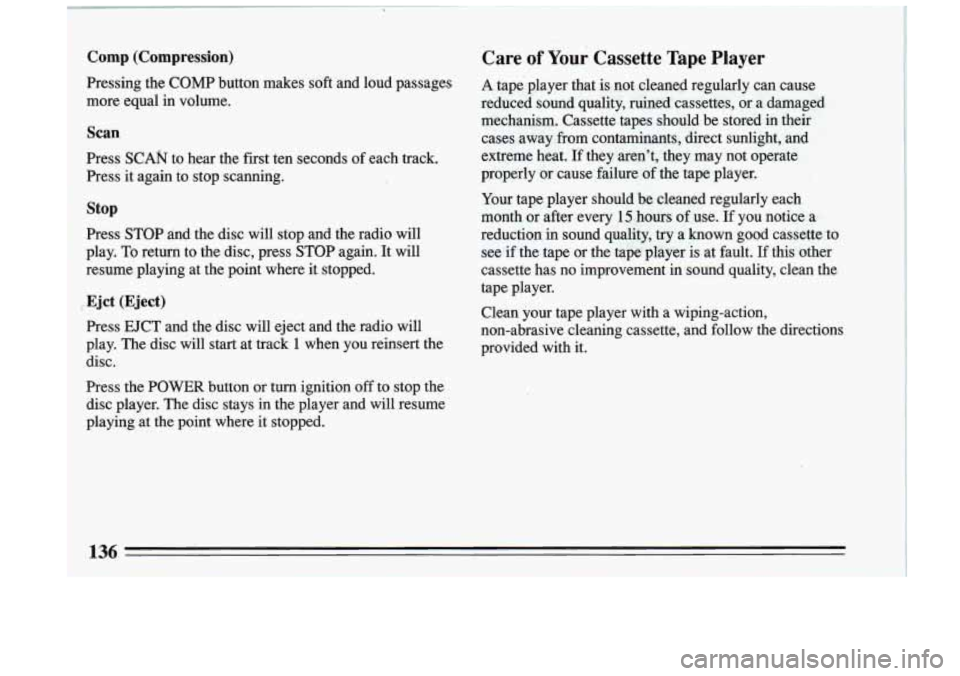
Comp (Compression)
Pressing the COMP button makes soft and loud passages
more equal
in volume.
Scan
Press SCAN to hear the first ten seconds of each track.
Press it again to stop scanning.
stop
Press STOP and the disc will stop and the radio will
play. To return to the disc, press STOP again. It will
resume playing at the point where it stopped.
Ejct (Eject)
Press EJCT and the disc will eject and the radio will
play. The disc will start at track
1 when you reinsert the
disc.
Press the POWER button or turn ignition
off to stop the
disc player. The disc stays in the player and will resume
playing at the point where it stopped.
Care of Your Cassette Tape Player
A tape- player that is. not cleaned regularly can cause
reduced
sound quality, ruined cassettes, or a damaged
mechanism. Cassette tapes should be stored in their
cases away
from contaminants, direct sunlight, and
extreme heat. If they aren’t, they may not operate
properly or cause failure of the tape player.
Your tape player should be cleaned regularly each
month or after every
15 hours of use. If you notice a
reduction
in sound quality, try a known good cassette to
see if the tape or the tape player is at fault.
If this other
cassette has no improvement in sound quality, clean the
tape player.
Clean your tape player with a wiping-action,
non-abrasive cleaning cassette, aild follow the directions
provided with it.
I
136
I
Page 149 of 324

Your Own Signals
Drivers signal to others, too. It’s not only more polite,
it’s safer to let other drivers know what you are doing.
And in some places the law requires driver signals.
urn and lane change signals. Always signal when you
plan to turn or change lanes.
If necessary, you can use hand signals out the window:
Left arm straight out for a left turn, down for slow or
about-to-stop, and up for a right turn.
Slowing down. If time allows, tap the brake pedal once
or twice in advance of slowing or stopping. This warns
the driver behind you.
Disabled. Your four-way flashers signal that your
vehicle is disabled or is a hazard. See “Hazard Warning
Flasher” in the Index.
Traffic Officer
The traffic police officer is also a source of important
information. The officer’s signals govern, no matter
what the traffic lights or other signs say.
The next section discusses some of the road conditions
you may encounter.
Defensive Driving
The best advice anyone can give about driving is: Drive
defensively.
Please start with
a very important safety device in your
Buick: Buckle up. (See “Safety Belts” in the Index.)
Defensive driving really means “be ready for anything.”
On city streets, rural roads, or freeways, it means
“always expect the unexpected.”
Assume that pedestrians or other drivers are going to be
careless and make mistakes. Anticipate what they might
do. Be ready for their mistakes.
Expect children to dash out from behind parked cars, often- followed by other children. Expect occupants in
parked cars to open doors into traffic. Watch for
movement in parked cars
-- someone may be about to
open a door.
Expect other drivers to run stop signs when
you are on a
through street. Be ready to brake if necessary as you go
through intersections. You may not have to use the
brake, but
if you do, you will be ready.
If you’re driving through a shopping center parking lot
where there are well-marked lanes, directional arrows,
and designated parking areas, expect some drivers to
147
Page 162 of 324
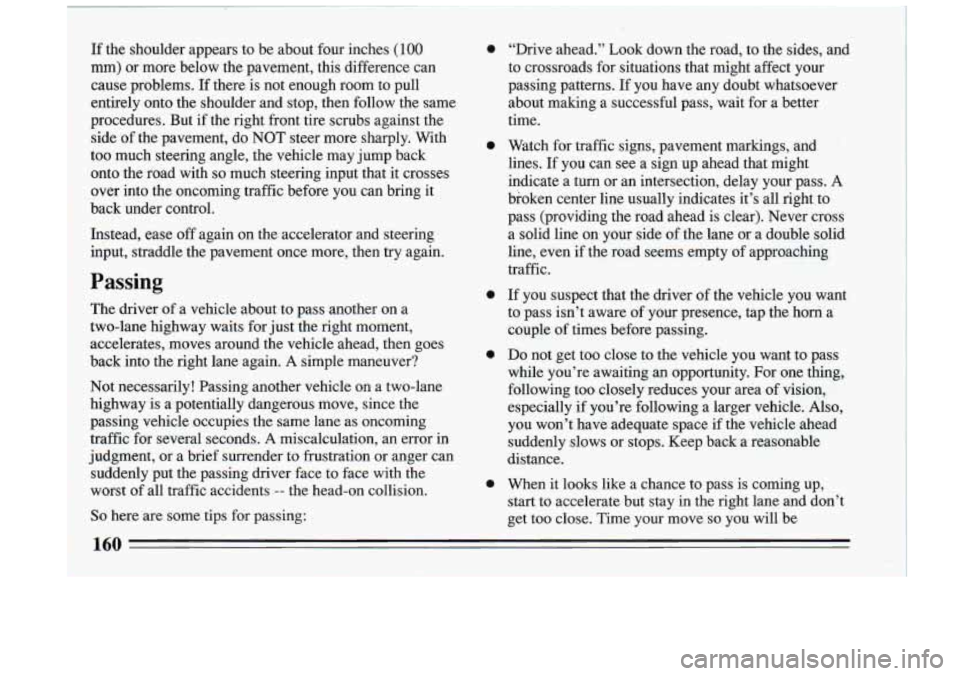
If the shoulder appears to be about four inches (100
mm) or more below the pavement, this difference can
cause problems.
If there is not enough room to pull
entirely onto the shoulder and stop, then follow the same
procedures. But if the right front tire scrubs against the
side of the pavement, do NOT steer more sharply. With
too much steering angle, the vehicle may jump back
onto the road with
so much steering input that it crosses
over into the oncoming traffic before you can bring it
back under control.
Instead, ease off again on the accelerator and steering
input, straddle the pavement once more, then try again.
Passing
The driver of a vehicle about to pass another on a
two-lane highway waits for just the right moment,
accelerates, moves around the vehicle ahead, then goes
back into the right lane again. A simple maneuver?
Not necessarily! Passing another vehicle on a two-lane
highway is a potentially dangerous move, since the
passing vehicle occupies the same lane as oncoming
traffic for several seconds. A miscalculation, an error
in
judgment, or a brief surrender to frustration or anger can
suddenly put the passing driver face to face with the
worst of all traffic accidents
-- the head-on collision.
So here are some tips for passing:
0
0
0
0
0
“Drive ahead.” Look down the road, to the sides, and
to crossroads for situations that might affect your
passing patterns. If you have any doubt whatsoever
about making a successful pass, wait for a better
time.
Watch for traffic signs, pavement markings, and
lines.
If you can see a sign up ahead that might
indicate a turn or an intersection, delay your pass.
A
broken center line usually indicates it’s all right to
pass (providing the road ahead
is clear). Never cross
a solid line on your side of the lane or a double solid
line, even
if the road seems empty of approaching
traffic.
If you suspect that the driver of the vehicle you want
to pass isn’t aware of your presence,, tap the
horn a
couple of times before passing.
Do not get too close to the vehiclc 3u want to pass
while you’re awaiting an opportunny. For one thing, following too closely reduces your area of vision,
especially
if you’re following a larger vehicle. Also,
you won’t have adequate space
if the vehicle ahead
suddenly slows
or stops. Keep back a reasonable
distance.
~~
When it looks like a chance to pass is coming up,
start to accelerate but stay in the right lane and don’t
get too close. Time your move
so you will be
160
Page 164 of 324
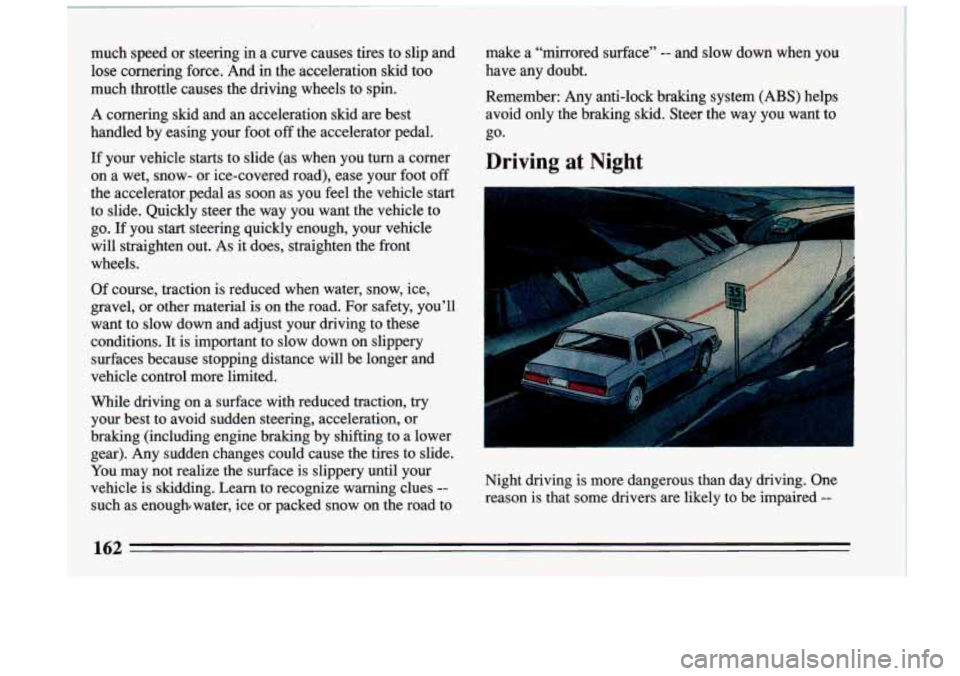
much speed or steering in a curve causes tires to slip and
lose cornering force. And in the acceleration skid too
much throttle causes the driving wheels to spin.
A cornering skid and an acceleration skid are best
handled by easing your foot
off the accelerator pedal.
If your vehicle starts to slide (as when you turn a corner
on a wet, snow- or ice-covered road), ease your foot
off
the acceleratorpedal as soon as you feel the vehicle start
to slide. Quickly steer the way you want the vehicle to go. If you
start steering quickly enough, your vehicle
will straighten out.
As it does, straighten the front
wheels.
Of course, traction is reduced when water, snow, ice,
gravel,
or other material is on the road. For safety, you’ll
want to slow down and adjust your driving to these
conditions. It is important to slow down on slippery
surfaces because stopping distance will be longer and
vehicle control more limited.
While driving on a surface with reduced traction,
try
your best to avoid sudden steering, acceleration, or
braking (including engine braking by shifting to a lower
gear). Any sudden changes could cause the tires to slide.
You may not realize the surface is slippery until your
vehicle is skidding. Learn to recognize warning clues
--
such as enoughewater, ice or packed snow on the road to make
a “mirrored surface” -- and slow down when you
have any doubt.
Remember: Any anti-lock braking system
(ABS) helps
avoid only the braking skid. Steer the way you want to
go.
Driving at Night
Night driving is more dangerous than day driving. One reason
is that some drivers are likely to be impaired --
162
I
Page 167 of 324
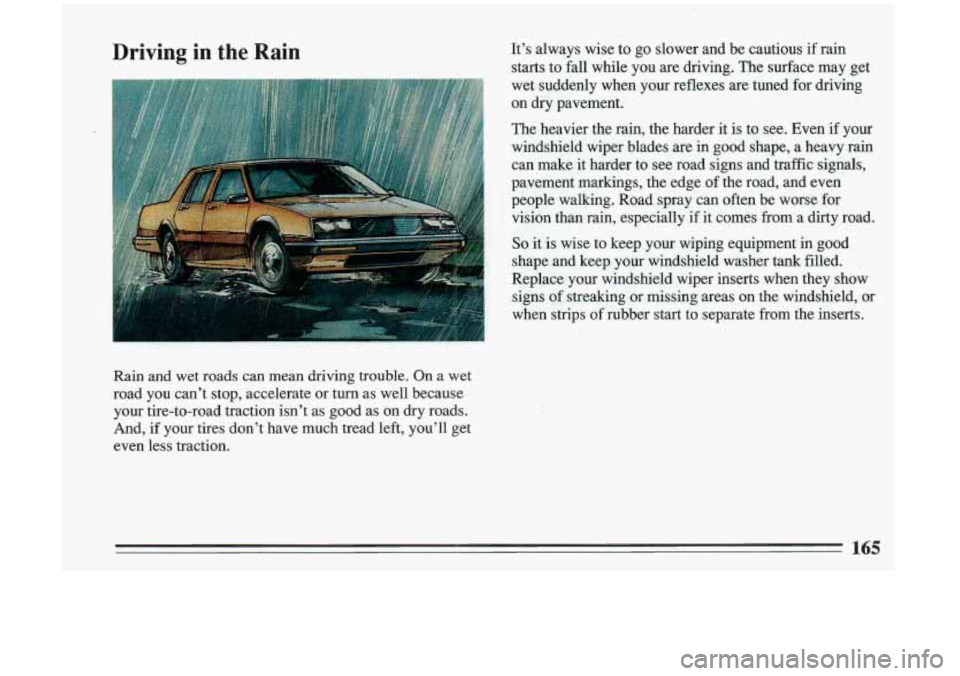
Driving in the Rain It’s always wise to go slower and be cautious if rain starts to fall while
you are driving. The surface may get
wet suddenly when your reflexes are tuned for driving
on dry pavement.
The heavier the rain, the harder it is to see. Even
if your
windshield wiper blades are in good shape, a heavy rain
can make it harder to see road signs and traffic signals,
pavement markings, the edge of the road, and even
people walking. Road spray can often be worse for
vision than rain, especially
if it comes from a dirty road.
So it is wise to keep your wiping equipment in good
shape and keep your windshield washer tank filled.
Replace your windshield wiper inserts when they show signs of streaking or missing areas on the windshield, or
when strips of rubber start to separate
from the inserts.
Rain and wet roads can mean driving trouble. On a wet
road you can’t stop, accelerate or turn as well because
your tire-to-road traction isn’t as good as on dry roads.
And, if your tires don’t have much tread left, you’ll ge\
t even less traction.
165